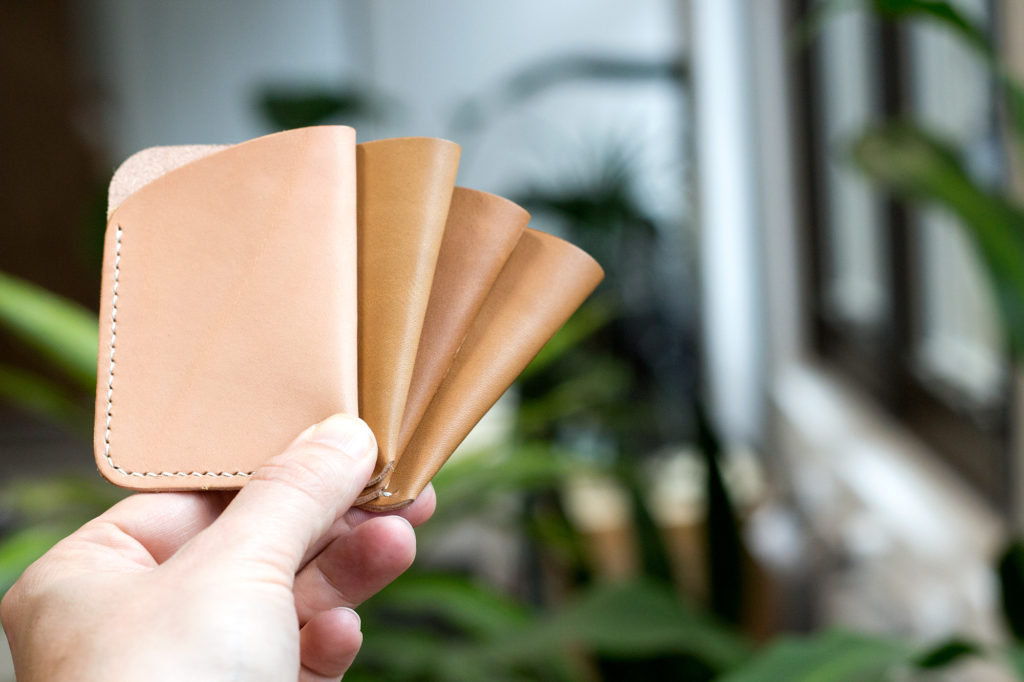Dyeing leather with coffee is a popular method for creating a unique and organic look. It is a simple process that involves soaking the leather in brewed coffee to achieve a dark brown color.
The tannins in the coffee act as a natural dye and can penetrate the surface of the leather, resulting in a beautiful, rustic finish. Coffee dyeing is often used to darken or stain leather items such as jackets, boots, or bags.
It is a cost-effective and environmentally friendly alternative to commercial leather dyes. Additionally, coffee-dyed leather has a distinct aroma that adds to its charm. In this blog post, we will explore the step-by-step process of dyeing leather with coffee and discuss some tips and tricks to achieve the best results.

Credit: makesupply-leather.com
The Allure Of Coffee-dyed Leather
There’s a timeless charm in the art of dyeing leather, and the use of coffee as a natural dye has been gaining traction in the world of leather crafting. The rich, earthy tones achieved through coffee dyeing lend a rustic and vintage appeal to leather goods, making them unique and environmentally friendly. The allure of coffee-dyed leather lies in its ability to evoke a sense of nostalgia and sustainability, making it a popular choice for eco-conscious artisans and consumers alike.
The Rise Of Eco-friendly Leather Dyeing
With the increasing focus on sustainable and eco-friendly practices, the leather industry has been seeking natural alternatives to synthetic dyes. This shift has led to the rise of eco-friendly leather dyeing methods, with artisans turning to organic sources such as coffee to achieve distinct and environmentally conscious results. The resurgence of traditional dyeing techniques has sparked a renewed interest in the art of crafting with natural materials, contributing to the appeal of coffee-dyed leather.
Why Coffee Is An Ideal Choice
Coffee’s natural pigments and tannins make it an ideal choice for dyeing leather, as it imparts rich, warm hues while also acting as a natural preservative. The use of coffee as a leather dye not only results in unique color variations, but also offers a sustainable and non-toxic alternative to conventional dyeing methods. The simplicity and accessibility of coffee as a dyeing agent further contribute to its appeal, allowing artisans to create distinct and environmentally friendly leather goods.

Credit: www.nahakamber.ee
Prepping Leather For Coffee Dyeing
To prepare leather for coffee dyeing, start by cleaning the leather with a damp cloth to remove any dirt or oils. Next, brew a strong pot of coffee and allow it to cool to room temperature. Then, submerge the leather in the coffee for several hours, periodically agitating the leather to ensure even dyeing.
Once the desired shade is achieved, remove the leather from the coffee and allow it to air dry before applying a leather conditioner to seal in the color.
Selecting The Right Leather
When preparing to dye leather with coffee, it’s crucial to select the right type of leather. Full-grain or top-grain leather works best for coffee dyeing due to its natural and porous surface, which allows for better absorption of the coffee dye.
Cleaning Leather Before Dyeing
Prior to dyeing the leather with coffee, thorough cleaning is essential to ensure the dye adheres properly and the final color is consistent. Gently wipe the leather with a damp cloth to remove any surface dirt and dust. For stubborn stains, use a mild leather cleaner to ensure the leather is free from any contaminants that may hinder the dyeing process.
Brewing The Perfect Dye
When it comes to dyeing leather with coffee, brewing the perfect dye is essential to achieve the desired color and effect. The type of coffee beans and the concentration of the coffee are two factors that play a crucial role in the dyeing process.
Choosing Coffee Beans
The choice of coffee beans will determine the shade and richness of the dye. For a darker hue, opt for dark roast coffee beans, such as French roast or Italian roast. These beans have a stronger flavor and higher concentration of natural pigments, resulting in a deeper color when used as a dye.
On the other hand, if you prefer a lighter shade, go for medium roast coffee beans. These beans have a milder flavor and a lighter color profile, which will produce a more subtle hue on the leather.
Coffee Concentration For Dyeing
The concentration of the coffee solution will also affect the final color of the leather. To achieve a darker and more intense shade, use a higher concentration of coffee. Conversely, if you prefer a lighter and more diluted color, opt for a lower concentration.
A general guideline is to use a ratio of 1 part coffee to 3 parts water for a medium concentration. However, you can adjust the ratio according to your desired color intensity. Remember to brew the coffee to its full strength before using it as a dye.
It’s important to note that the concentration of the coffee solution may require some experimentation to achieve the desired result. Start with a small batch and test it on a scrap piece of leather before dyeing the entire surface.
Once you have chosen the right coffee beans and determined the appropriate concentration, you are ready to proceed with the dyeing process. Make sure to prepare the leather properly by cleaning and conditioning it before applying the coffee dye.
By brewing the perfect dye with the right coffee beans and concentration, you can transform your leather items into unique pieces with a rich, organic color that is both stylish and eco-friendly.

Credit: m.youtube.com
The Dyeing Process
Immersing Leather In Coffee
Dyeing leather with coffee is a simple and natural way to give your leather items a unique, rustic look. To start the dyeing process, you’ll need to prepare a strong batch of coffee. Brew a pot of coffee using dark roast coffee grounds for a richer color. Allow the coffee to cool down to room temperature before proceeding.
Duration For Optimal Stain
The duration for immersing the leather in coffee will depend on the desired depth of color. For a lighter stain, you can soak the leather for about 30 minutes. If you prefer a darker and more intense color, you can leave the leather immersed in coffee for up to 24 hours. Keep in mind that the longer you soak the leather, the darker the stain will become.
After-dye Care
Learn how to care for leather dyed with coffee to maintain its rich color and quality. After dyeing leather with coffee, gently remove excess dye and sugars, and consider applying a protective leather conditioner to keep it looking great for years to come.
After-Dye Care:
Once you have successfully dyed your leather using coffee, it is important to take good care of it to maintain its color and quality. Here are some important steps to follow for after-dye care:
H3: Removing Excess Dye:
After dyeing your leather with coffee, there may be some excess dye left on the surface. To remove this, you can gently wipe the leather with a clean, damp cloth. Be careful not to use too much water or rub too hard, as this can damage the leather. You can also use a leather cleaner or conditioner specifically designed for dyed leather to remove any excess dye.
H3: Drying and Conditioning:
After removing any excess dye, allow the leather to dry completely before conditioning it. You can air-dry the leather or use a fan to speed up the drying process. Once the leather is dry, apply a leather conditioner to keep it soft and supple. Be sure to use a conditioner that is specifically designed for dyed leather, as some conditioners can strip away the dye.
To ensure the longevity of your coffee-dyed leather, it is important to take good care of it. By following these simple after-dye care steps, you can maintain the beautiful color and quality of your leather for years to come.
Creative Techniques And Patterns
Achieve a unique and earthy look by dyeing leather with coffee, a creative technique that imparts a rich, deep brown hue. This natural dyeing method offers a sustainable and organic approach to leather crafting, resulting in beautiful and distinctive patterns.
Achieving Different Shades
Dyeing leather with coffee is a great way to achieve different shades of brown, from light to dark. The longer you leave the leather in the coffee, the darker the shade will be. For a lighter shade, you can simply dip the leather quickly in the coffee and remove it. If you want a darker shade, you can leave the leather in the coffee for a longer period of time. The type of coffee you use can also affect the shade. Darker roast coffee will produce a darker shade, while lighter roast coffee will produce a lighter shade.
Pattern Dyeing With Coffee
If you want to add some creativity to your leather dyeing project, you can try pattern dyeing with coffee. This involves using various techniques to create unique patterns on the leather. Some techniques include using stencils, painting designs with a brush, and using different materials to create texture. You can also try tie-dyeing the leather with coffee for a more bohemian look. The possibilities are endless, and pattern dyeing with coffee is a great way to add some personality to your leather items.
In conclusion, dyeing leather with coffee is a fun and eco-friendly way to give your leather items a new look. With the ability to achieve different shades and experiment with pattern dyeing, coffee dyeing is a great technique to add to your DIY arsenal. So next time you’re sipping on your morning coffee, consider saving some for your next leather dyeing project.
Troubleshooting Common Issues
When it comes to dyeing leather with coffee, there can be some common issues that may arise. However, with a few simple techniques, you can easily troubleshoot these problems and achieve the desired results. In this section, we will discuss how to prevent uneven tones, as well as how to deal with stains and spills.
Preventing Uneven Tones
One common issue when dyeing leather with coffee is achieving uneven tones. This can occur when the coffee is not applied evenly or when the leather absorbs the dye differently in certain areas. To prevent this problem, follow these steps:
- Prepare the coffee mixture by brewing a strong batch of coffee.
- Allow the coffee to cool down to room temperature.
- Before applying the coffee dye, make sure to clean the leather thoroughly to remove any dirt or oils that may interfere with the dye absorption.
- Apply the coffee dye using a clean cloth or sponge, ensuring even coverage across the entire surface.
- Allow the leather to dry completely before applying additional coats if desired.
By following these steps, you can minimize the chances of getting uneven tones and achieve a more consistent color throughout the leather.
Dealing With Stains And Spills
Another common issue when dyeing leather with coffee is dealing with stains and spills. Accidental spills or stains can happen during the dyeing process, but there are ways to address these problems:
- If a spill occurs, act quickly by blotting the area with a clean cloth or paper towel to absorb as much of the coffee as possible.
- Avoid rubbing the stain, as this can spread it further into the leather.
- Once the excess coffee is absorbed, gently clean the stained area with a mild soap and water solution. Be careful not to saturate the leather.
- Rinse the area with clean water and pat dry with a soft cloth.
- If the stain persists, you can try using a leather cleaner specifically designed for removing stains.
Remember to always test any cleaning solution on a small, inconspicuous area of the leather before applying it to the stained spot.
By following these steps, you can effectively address stains and spills that may occur during the dyeing process and ensure a successful outcome for your leather project.
Protecting Your Coffee-dyed Leather
Once you have successfully dyed your leather with coffee, it’s important to take steps to protect and preserve the color. In this section, we will explore the various methods and tips for maintaining the longevity of your coffee-dyed leather.
Sealants And Finishers
To provide an extra layer of protection to your coffee-dyed leather, you can use sealants and finishers. These products help to seal the dye and prevent it from fading or rubbing off over time. There are different types of sealants and finishers available, such as:
| Type | Description |
|---|---|
| Acrylic Finisher | A water-based finisher that provides a clear protective coat without altering the color of the leather. |
| Resolene | A popular choice for leather finishing, Resolene offers a glossy finish and excellent protection against moisture and dirt. |
| Beeswax | Natural beeswax can be used to create a protective barrier on the leather, enhancing its durability. |
Before applying any sealant or finisher, make sure to clean the leather thoroughly and allow it to dry completely. Follow the manufacturer’s instructions for application, and consider testing on a small, inconspicuous area before applying it to the entire surface.
Maintenance Tips
To keep your coffee-dyed leather looking its best, follow these maintenance tips:
- Regularly clean the leather using a soft, damp cloth to remove dirt and dust.
- Avoid exposing the leather to direct sunlight for prolonged periods, as it can cause fading.
- Store the leather in a cool, dry place to prevent moisture damage.
- Avoid using harsh chemicals or abrasive cleaners on the leather, as they can damage the dye.
- If the leather becomes stained, gently blot the area with a clean cloth and use a leather cleaner specifically designed for dyed leather.
- Consider reapplying a protective sealant or finisher every few months, depending on the level of use and exposure.
By following these tips and using appropriate sealants and finishers, you can ensure that your coffee-dyed leather remains vibrant and protected for years to come.
Frequently Asked Questions
What Is The Best Natural Dye For Leather?
Coffee is one of the best natural dyes for leather. It creates a dark brown color and is easy to apply. Other natural dyes for leather include acorns, henna, and vinegaroon. Coconut oil can also be used to darken leather naturally.
Wine, curry, pomegranate juice, and lemon juice are other unusual ways to dye veg-tanned leather. Alcohol-based and water-based leather dyes are also popular options.
How Do You Darken Leather Naturally?
To darken leather naturally, you can use coconut oil. Apply a small amount of coconut oil to the leather item and it will gradually become a darker shade. Avoid using excessive oil to prevent a strong smell. This method is effective for leather boots, jackets, and other clothing items.
How To Dye Leather Without Leather Dye?
To dye leather without leather dye, you can try using alternative methods such as coffee, wine, curry, pomegranate juice, beer, seaweed, or lemon juice. These natural ingredients can create unique and interesting colors on undyed leather. Another option is to darken leather naturally using coconut oil.
These methods provide a more organic and eco-friendly approach to dyeing leather.
What Can I Use To Dye Leather?
You can use various natural items to dye leather, such as coffee, acorns, henna, wine, curry, pomegranate juice, beer, cider, ale, rose petals, seaweed, and lemon juice. Coffee is an effective and easy option for dyeing leather, and it creates a dark brown shade.
You can also darken leather naturally with coconut oil or by exposing it to the sun. Alcohol-based leather dyes, water-based leather dyes, and resin are other options.
Can I Dye Leather With Coffee At Home?
Yes, you can easily dye leather with coffee at home. It’s a natural and eco-friendly way to give your leather items a unique and rustic look.
Conclusion
To conclude, dyeing leather with coffee is a great way to give your leather items a natural, unique look. It’s an easy and affordable DIY project that anyone can do at home. Remember to use freshly brewed coffee for the best results and remove any excess dye and sugars to avoid staining.
With a bit of patience and practice, you can achieve beautiful results and create one-of-a-kind leather pieces that are sure to impress. So, why not give it a try and see what you can create with this simple yet effective technique?




